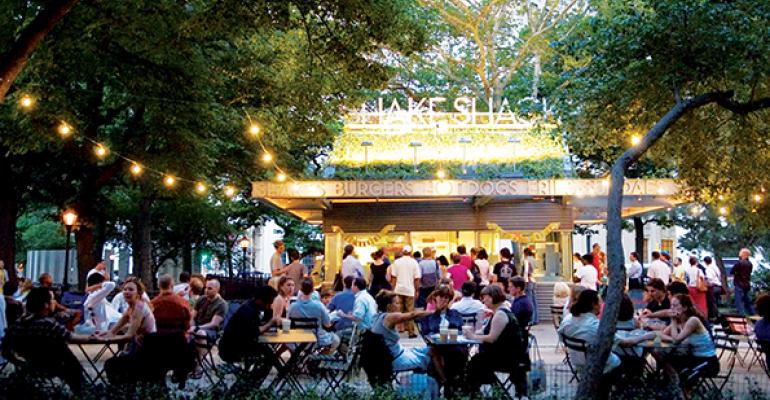Wall Street’s view of Shake Shack Inc. has moderated over the past two weeks. Since its stock price surged past $90 a share on May 22, seemingly on its way to triple digits, it has fallen more than 18 percent.
Shake Shack still has one of the highest valuations among publicly traded restaurant chains, with an enterprise value multiple of more than 140 times earnings before interest, taxes, depreciation and amortization, according to Bloomberg. Its market cap is $2.7 billion, or about $40 million per location, including franchised units.
Investors buy stock based on what they think will happen, so investors believe Shake Shack will grow, even if they have backed off some of their earlier enthusiasm.
But there is some debate about how big Shake Shack can get, according to Bloomberg. The burger market is intensely competitive, with numerous fast-casual players like Five Guys Burgers and Fries and Smashburger, as well as major regional burger chains like In-N-Out, Whataburger and Culver’s.
If Shake Shack had 450 units, it would be bigger than many established burger chains. In-N-Out currently has 299 locations, while White Castle has 391 locations and Krystal has 354 restaurants.
But a projection of 450 locations is small.
Rare is the restaurant chain that actually fulfills unit count projections. They are typically long-term benchmark estimates used by CEOs to convince investors they have white space and the ability to grow — which is what potential shareholders are looking for in a concept. As such, many of these projections are inflated.
That doesn’t appear to be the case with Shake Shack. At 450 units, the burger chain wouldn’t even be among the 50 largest concepts among the entire restaurant industry in terms of unit count.
By comparison, Red Robin Gourmet Burgers has 496 units. Culver’s, the Prairie du Sac, Wis.-based regional quick-service chain, has 528 locations. Steak ’n Shake — the chain that inspire Shake Shack creator Danny Meyer — has 536 restaurants. None of those are among the 50 largest concepts. Five Guys, the gold standard for unit count among fast-casual burger chains, has 1,163 locations, nearly triple Shake Shack’s projection.
In other words, Shake Shack is limiting its growth potential. It suggests that the chain sees itself as something of a destination concept in many of its markets. It does not expect to be on every street corner.
“The 450 unit number is doable,” said John Gordon, a San Diego-based restaurant consultant.
But unit count can be a misleading measure of a chain’s success because it doesn’t measure how many hamburgers a restaurant actually sells. The crucial question is whether Shake Shack can maintain its unit volume.
Shake Shack expects to draw many customers to relatively few locations. The company estimates its average unit volume to ultimately range from $2.8 million to $3.2 million. That’s considerably less than the current $5 million, which is fair, as many of its current locations are in Manhattan, where unit volumes are inflated.
A $3 million average unit volume would still be among the highest in the quick-service segment, although perhaps less than Chick-fil-A. It would be the highest among burger chains, including both McDonald’s Corp. and In-N-Out.
Combine the projected unit volumes with the projected unit count, and Shake Shack expects to generate nearly $1.4 billion in systemwide sales some day. That would be larger than Five Guys, In-N-Out and Steak ’n Shake, but less than Whataburger or Hardee’s, among others.
That will be a tougher goal to accomplish. But considering the typically pie-in-the-sky nature of expansion projections, it is still modest.
Contact Jonathan Maze at [email protected]
Follow him on Twitter: @jonathanmaze





